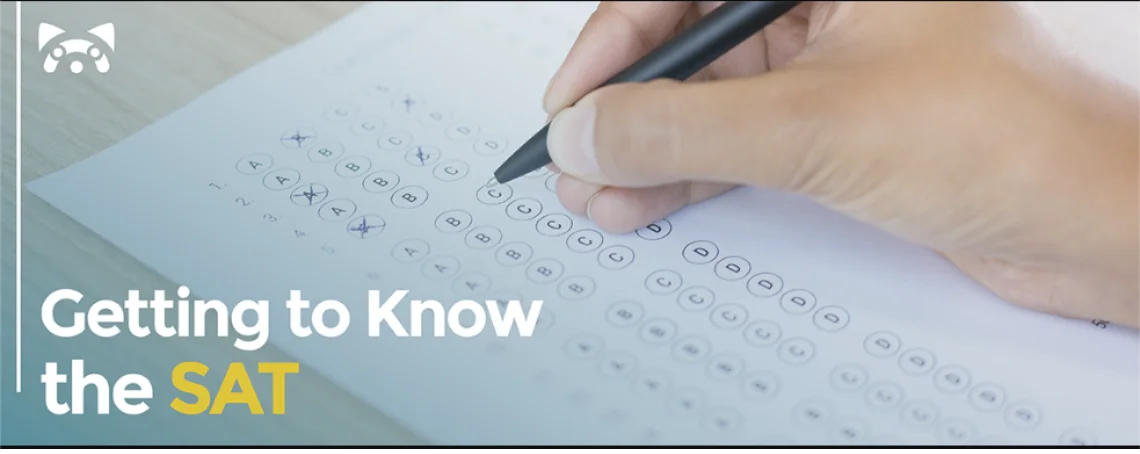The SAT exam is so much more than just a test. It’s a tool that can unlock doors to higher education, showing colleges a snapshot of a student’s abilities in math, reading, and writing. As schools increasingly revert to requiring standardized tests for admission, understanding and excelling in the SAT has become crucial once more.
The SAT Role in College Admissions
The SAT was first introduced in 1926 to establish a standardized measurement for college-bound students. As attending college became more of a norm, there was a need to find a measurement outside of a grade point average (GPA) to assess students’ academic performance.
This was due to the varying levels of difficulty of courses at schools across the country and around the world. With the help of the SAT, admissions counselors could test all students on the same material.
Since that time, colleges and universities have either required or strongly recommended students to send in their SAT scores as part of their application material.
One of the best ways to prepare for the SAT is to take the Preliminary SAT, or the PSAT—the younger sibling, so to speak, of the SAT. This test is shorter than the SAT but will ask similar questions that are comparably difficult to the ones you will find on the SAT.
Before taking the PSAT, students typically begin discussing the best study practices and when to start studying with guidance counselors, friends, and family. The SAT is not the type of test for which cramming the night before will be effective (not that any test is!).
While there are hundreds of different approaches to the SAT, one of the most important strategies is to spend time getting to know the exam.
SAT Format and Structure
SAT Reading and Writing
Number of modules: 2
Module’s length: 32 mins each
Total length: 64 mins
Elements: passages/pairs of passages
The SAT’s Evidence-Based Reading and Writing section is an intellectual expedition through diverse texts and rigorous language tasks. This section immerses students in a rich tapestry of literature, sciences, and humanities. By engaging with a variety of readings, students refine their comprehension skills, critical thinking abilities, and capacity to synthesize information.
SAT Math
Number of modules: 2
Module’s length: 35 mins each
Total length: 70 mins
Elements: algebra I and II, geometry, and some trigonometry
Venture into the SAT Math section, where numbers and formulas unlock the doors to academic achievement. This section, divided into two progressively challenging parts, provides an arena for students to exhibit their mathematical prowess. Here, students encounter a range of problems that demand logical thinking, precision, and creativity.
How Early Should You Start Preparing for the SAT
Deciding when to start preparing for the SAT can feel overwhelming, but it doesn’t have to be. Many students tackle this standardized test multiple times during their junior and senior years. Preparation, however, should follow a personalized approach. Begin by evaluating your current levels in math and verbal skills. This will serve as the baseline to determine how much preparation you might need. Consider which math topics you’ve covered in school so far. Have you mastered linear equations? What about advanced algebra? These are key areas in the SAT Math section.
Remember: Each student’s SAT journey is unique. Set goals aligned with college application timelines and your personal readiness for college.
SAT vs ACT
Deciding between the SAT and ACT can be an essential step in your college application journey! Both are standardized tests designed to showcase your academic abilities, but they have distinct differences. While the SAT emphasizes Math, Reading, and Writing, the ACT tests these areas, plus Science, while also delving into more advanced math topics such as trigonometry.
Key Differences
Test Structure
SAT: Two main sections—Math and Evidence-Based Reading and Writing
ACT: English, Math, Reading, and Science
Math Questions
SAT math questions often require deeper analysis, while ACT math is more direct, albeit covering advanced topics.
Reading & Writing
The SAT features longer passages that require heavy reading comprehension through multiple-choice questions. On the other hand, the ACT divides Reading and English into separate sections.
SAT Tips
Let’s delve into some empowering tips that can enhance your SAT performance and bring you closer to your college dreams.
Take SAT Practice Tests
Practice tests are a vital component of any effective SAT prep strategy. They not only familiarize you with the test structure but also help you identify and focus on your weaker areas. While the internet is flooded with numerous practice test resources, not all offer quality material. Zinkerz offers SAT Mock tests that mirror the authentic SAT experience.
What’s the best strategy to prepare for the SAT? Consistency is key. See Jill’s golden tips on SAT success.
Work on Your Knowledge Gaps
Identifying your knowledge gaps and working diligently to close them is crucial in your SAT preparation journey. Concentrating your efforts on areas where you’re less confident not only bolsters your overall test performance but also elevates your academic abilities across subjects. The first step is honest self-assessment to pinpoint subjects that need improvement. Once these areas are identified, create a structured study plan that prioritizes these weak spots.
At Zinkerz, our students begin their SAT journey with us by taking an initial diagnostic test. This allows us to identify foundational strengths and areas for improvement across key academic areas.
Explore SAT Math Video Explanations
Mathematics can be a daunting subject for many, but approaching it with a fresh perspective can make all the difference. SAT Math Video Explanations are a powerful tool to simplify complex topics and offer step-by-step solutions to challenging math questions. We recommend the Digital SAT Math Hacks playlist.
Make the Most of the Digital Desmos Calculator
At Zinkerz, we understand the importance of familiarizing yourself with Desmos, which is why our classes focus on teaching you where and how to employ this calculator effectively. With the aid of our dedicated YouTube channel, which explores numerous math problems solved with the Desmos tool, we empower you to harness its full potential. This solidifies your understanding, enabling you to tackle even the most complex questions with confidence.
Use These Last-Minute Hacks
When the clock is ticking down to test day, having a few tried-and-true last-minute SAT hacks up your sleeve can be invaluable. One tip is to focus on quality over quantity; hone in on areas that can offer the most significant return on investment, such as refining your writing skills or revisiting common questions. Another strategy is to simulate test conditions in your final practice sessions, which helps acclimate you to the pace and pressure of the actual exam.
How to Manage SAT Anxiety
Preparing for the SAT is like gearing up for a race. You wouldn’t run a marathon without training, and the same holds true for this pivotal test in the college application process. Exposure to the exam format and practice questions can boost your confidence and significantly lower anxiety.
Here’s how you can prepare effectively:
- Practice, practice, practice: Just like athletes train, taking mock exams can acclimate you to the exam conditions, alleviating the stress of the unknown.
- Create a pacing plan: Develop a strategy to manage your time effectively during the test. Practicing with a plan ensures you can handle the pacing of the actual exam day.
- Build a toolbox of strategies: Equip yourself with various strategies for tackling multiple-choice questions, solving linear equations, and refining your writing skills.
What Is a “Good” SAT Score
Wondering what constitutes a “good” SAT score? While it varies by institution, achieving above the 50th percentile is a promising start. Most prestigious colleges seek scores in higher percentiles, reflecting readiness for college. Use our online SAT score calculator to get an idea of what score to expect.
SAT Score Importance:
| Percentile | Implication |
| 25th | Below average |
| 50th | Average score |
| 75th+ | Above average, competitive |
“There really is no one-size-fits-all approach to the SAT. Every child is unique, and that means that they need their own approach. Typically, it takes time to reach the maximum score that a student is capable of achieving through practice, classes, and repeated exposure.
The kind of improvement that can be expected really does vary from child to child. But our average increase is 350 points from the first to last exam,” says Jill K., a Zinkerz team member.
Above all, succeeding on the exam is about meeting students where they are and crafting personalized goals. Remember, while not the sole deciding factor, a strong SAT performance can open doors and enhance college application outcomes.
Improve Your Score with Zinkerz
By taking a broad study approach, you will realize that the SAT isn’t as scary as people make it out to be. Likewise, by studying how the test is set up, you will have a better idea of how to approach the test and what areas you should spend most of your time studying.
Our prep courses offer expert advice to help you navigate the Math Section and the Evidence-Based Reading and Writing section efficiently. You can not only work toward an average score but truly excel, standing out in the competitive world of college applications.
Discover all about our test prep courses.
SAT FAQs
When do you take the SAT?
Deciding when to tackle the SAT is a strategic milestone for any school student eyeing college admissions. Most students opt to take the SAT in their junior year of high school. This timing allows students to retake the exam in the fall of their senior year, if needed, to improve their results and strive for perfect scores. The SAT is typically offered seven times a year in the U.S. Check the announced SAT test dates.
How to cram for the SAT?
Attempting to cram for the SAT is like trying to learn a symphony overnight. Success lies not in last-minute review but with consistent, deliberate practice—much like perfecting a piano concerto for a prestigious performance. To truly excel in the SAT and secure scores that shine in the admissions process, you need to commit to regular practice.
How long is the SAT?
The SAT is a test of endurance as much as intellect, designed to stretch your academic muscles over a standard duration of 2 hours and 14 minutes, interspersed with a 10-minute break to recalibrate and refocus.
How many times can you take the SAT?
Most students choose to take it between two and three times, using their previous score reports as a roadmap to highlight academic strengths and pinpoint areas for improvement. Tackling the exams multiple times can help students hone their readiness for college by refining their strategy with each effort and elevating their raw scores closer to a competitive score.
What to bring on Test Day?
- Your fully charged testing device with the Bluebook™ application installed.
- Your up-to-date admission ticket from the Bluebook app.
- Acceptable photo ID.
- Pencils or pens.
See all the items you can bring on the College Board.


